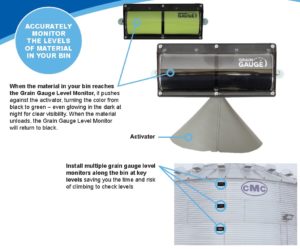A Shovel, Two Buckets and a Broken Leg
A misplaced valve on the grain leg resulted in bushels of soybeans dumped into a bin full of corn. Loren headed up the bin ladder carrying a shovel and two buckets to start bailing out the mess. A slip on the wet ladder as he climbed with one arm loaded sent him plunging to the ground. The young farmer’s head narrowly missed hitting an auger, but his leg was badly broken. Now there is the problem of physical injury added to the issue of mixed soybeans and corn.
Managing grain in tall storage bins is a work necessity for thousands of farmers, feed mill and grain elevator workers. Augers are moved into place to fill the bins, nearly -empty bins are  shoveled and swept, ladders are climbed to check grain quality and to see how full the bins are. Not only are there health risks to these tasks, but they are very difficult for workers with any type of physical impairment. It is not possible to eliminate all risks when storing grain, but steps can be taken to increase worker safety, accessibility and efficiency. In this article we’ll look at a few of the many possible accommodations for filling, managing and emptying grain bins.
shoveled and swept, ladders are climbed to check grain quality and to see how full the bins are. Not only are there health risks to these tasks, but they are very difficult for workers with any type of physical impairment. It is not possible to eliminate all risks when storing grain, but steps can be taken to increase worker safety, accessibility and efficiency. In this article we’ll look at a few of the many possible accommodations for filling, managing and emptying grain bins.
An Auger Positioning Concrete Pad guides a grain transfer auger into position so it is lined up with the opening in the top of a grain storage bin. Without this, a farmer will guide the auger into position by visually estimating if it is lined up with the grain bin opening. With good vision, it may take 2 or 3 attempts to position the auger properly. For a worker with vision in only one eye, it is nearly impossible due to the absence of depth perception.
The Auger Positioning Concrete Pad is be built by first setting up the auger in proper position, marking the proper position for the wheels and the hitch, and then pouring a concrete pad with curbs around two sides of the wheels. In the future, the worker will be able to simply back the auger up onto the concrete pad until it bumps the curbs, and he will know the top of the auger is positioned properly above the bin opening. This eliminates the need to climb out of the tractor and onto the bin multiple times. The Auger Ace from Yetter Company (www.yetterco.com) also allows the side-shifting of augers with a hydraulic cylinder to make slight adjustments when positioning augers.
Bin Level Indicators allow a farmer to know how full his bin is without climbing the ladder to look in. When filling the bins at harvest or filling feed bins for livestock, the farmer must climb the bin ladder to see how full the bin is to prevent overflowing the grain. The indicators are mounted to the bin wall and are pressure activated so when grain comes in contact with them, a buzzer 

Grain bin steps are mounted to the side of a grain storage bin instead of a ladder to make it easier for the farmer to climb and look in his bins. Grain is dried and stored in bins from harvest until it is sold. The farmer would need to climb the bins up to 10 times while filling, storing and emptying the grain. Vertical ladders require strong grip with two hands and good leg strength while climbing the 15 to 30 feet to the top of the bin. Bin steps look like a stairway curving around the side of the bin with a railing to prevent falling.
Pressurized Air Purifier Helmets filter dust and mold from the air as workers clean out bins. The helmet has a clear face shield with an elastic tyvek chin seal that prevents dust from entering the mouth and nose area. A battery operated fan draws air through a filter and blows it into the facemask to provide a constant stream of flowing fresh air.
Sweep augers empty grain out of bin sides so a worker does not need to shovel so much grain piled around the edges of the bin. However, carrying augers in and out of partially filled bins is very difficult, especially if a worker has a back injury. A direct-drive bin floor unloader auger is a better option because it stays permanently in the bin. Standard sweep augers require lifting in and out of the bin each year.


If Loren had installed bin steps instead of a vertical ladder up the side of his bin, he could have carried a shovel and bucket up the bin more safely. Although risk of injury cannot be completely eliminated, investing in a plan of safety will improve the quality of life and efficiency of workers managing grain in bins. The cost of medical care and lost work time would have purchased several sets of bin steps for Loren. Although there are many low-cost ways to make grain handling safer and more accessible for workers, only a few could be discussed in this article. If you would like detailed information on how your specific grain management system could be improved, call Ned Stoller at 888-354-3289 or email ned@disabilityworktools.com.
